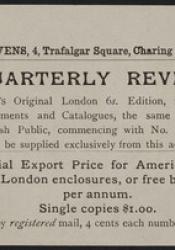The Quarterly Review
In 1809, John Murray started The Quarterly Review to describe current public opinions. It became a literary and political periodical that did not stop running until 1967. It did not encourage political reforms and often took a liberal-conservative stance. The Review was sometimes seen as radical and dismissive of other views and used its influence in London to reach the upper class. The periodical experienced several controversies for calling out famous poets, writers, politicians, and novelists. The editors attacked anyone who disagreed with their views and publicly criticized them.
Nevertheless, The Quarterly Review was judged as one of the most influential journals of the nineteenth century. Because of the conservative nature of the periodical, many of its articles sought to include a "moral review" of society. Some writers called for an adjustment of the community and British culture. The significance of the journal in the novel demonstrates Austen's awareness of the times and what the political atmosphere was like in the gentry class. It also was a nod to the inclusion of romantic philosophy in the journal that may have impacted her work.
Austen, Jane, and June Sturrock. “Chapter 10.” Mansfield Park, Broadview Press, Peterborough, Ontario, 2003, p. 127.
"Overview of the Quarterly Review under Gifford (1809-24)." Romantic Circles. Ed. Paul Youngquist and Orrin N.C. Wang. University of Colorado Boulder, 01 Feb. 2005. https://romantic-circles.org/reference/qr/founding/intro.html. Web. 7 Nov. 2022.
"Quarterly Review." Wikipedia, Wikimedia Foundation, 23 Jan. 2022, en.wikipedia.org/wiki/Quarterly_Review. Accessed 7 Nov. 2022.

